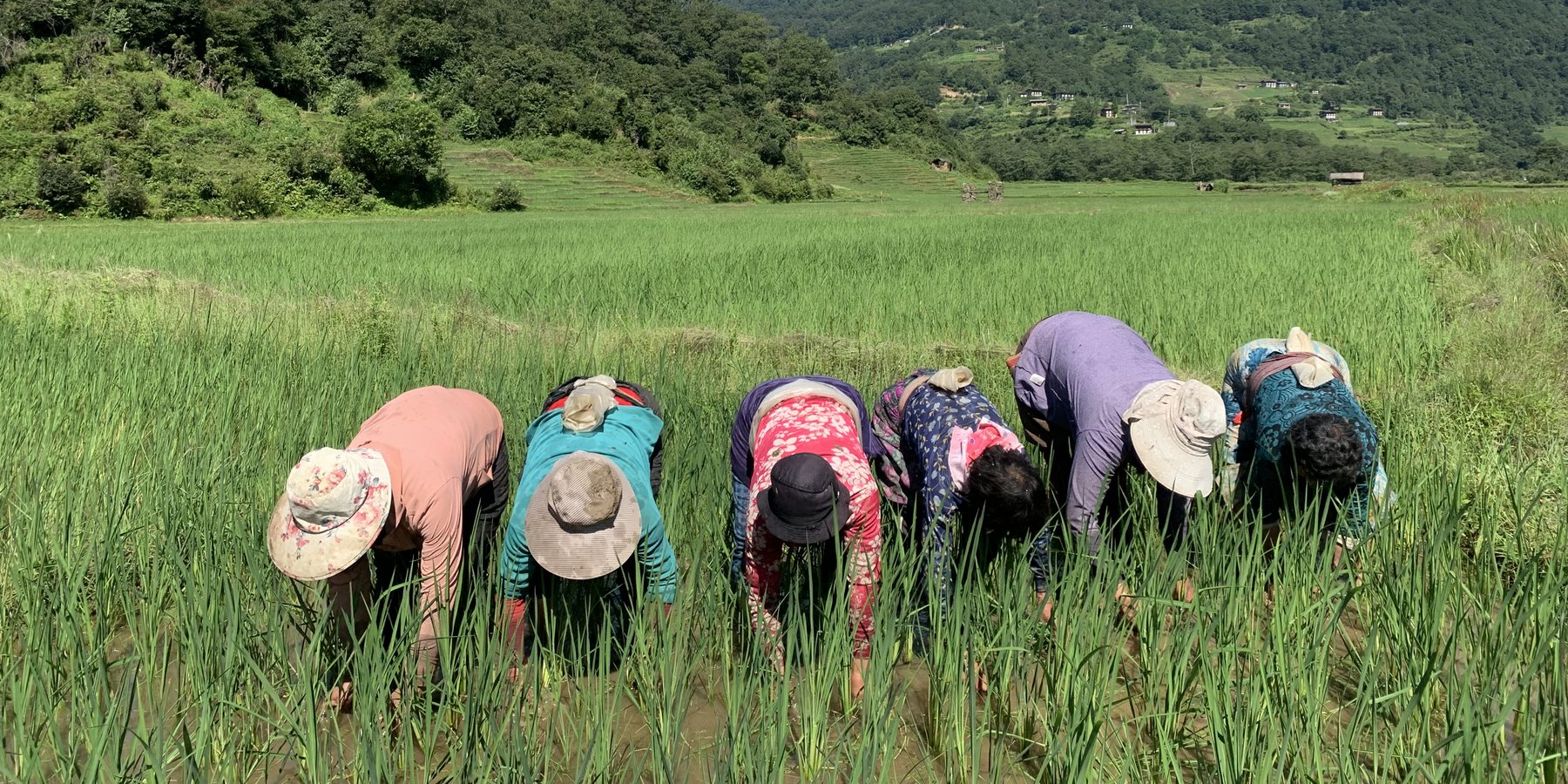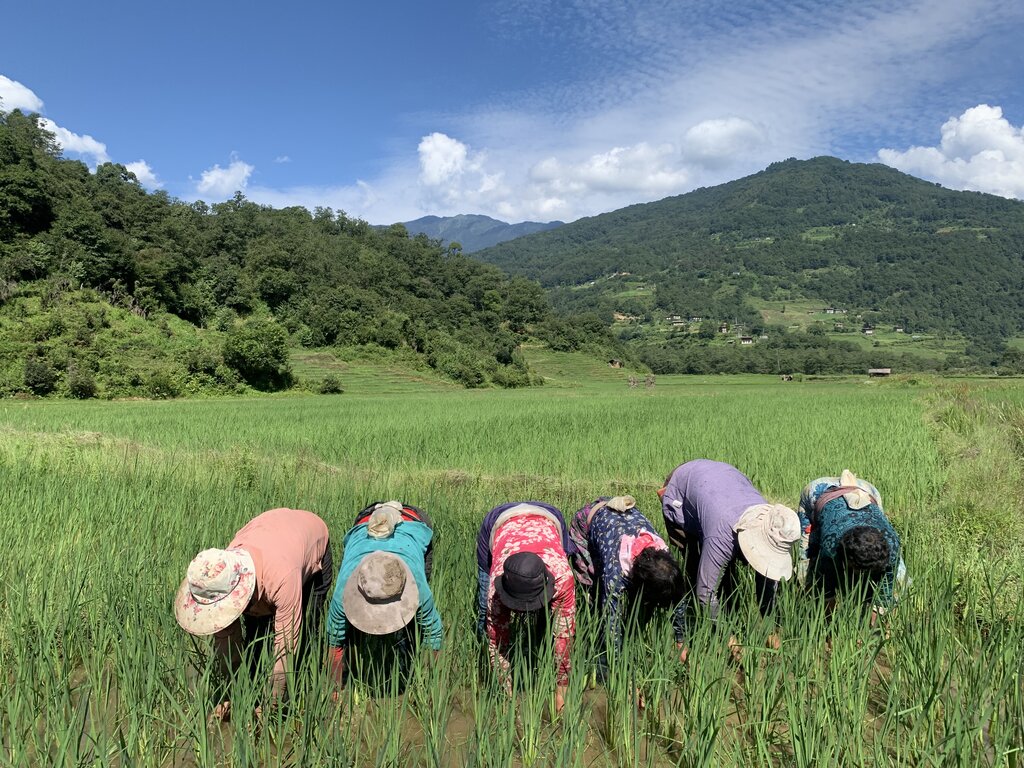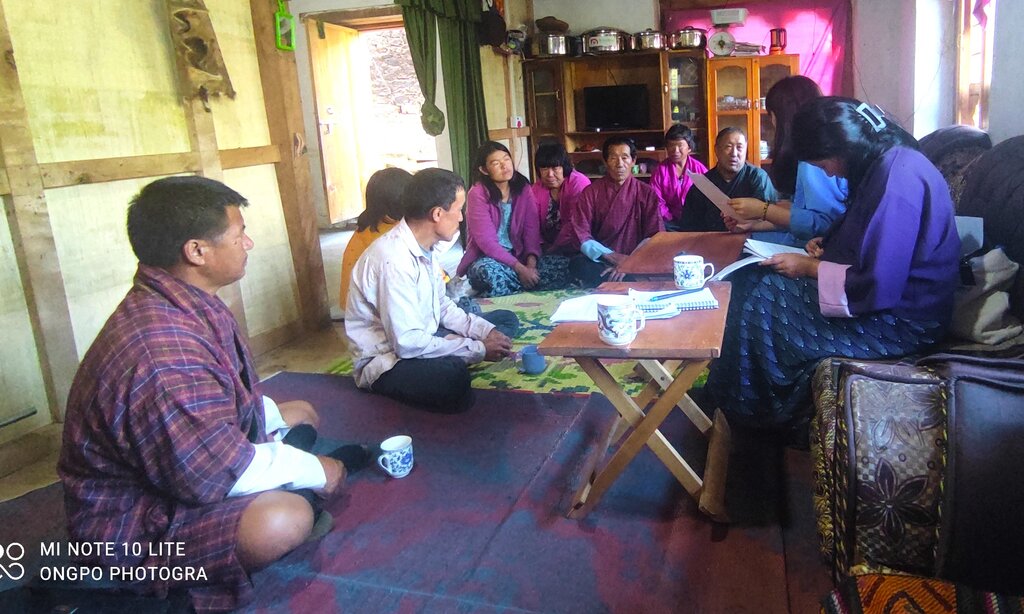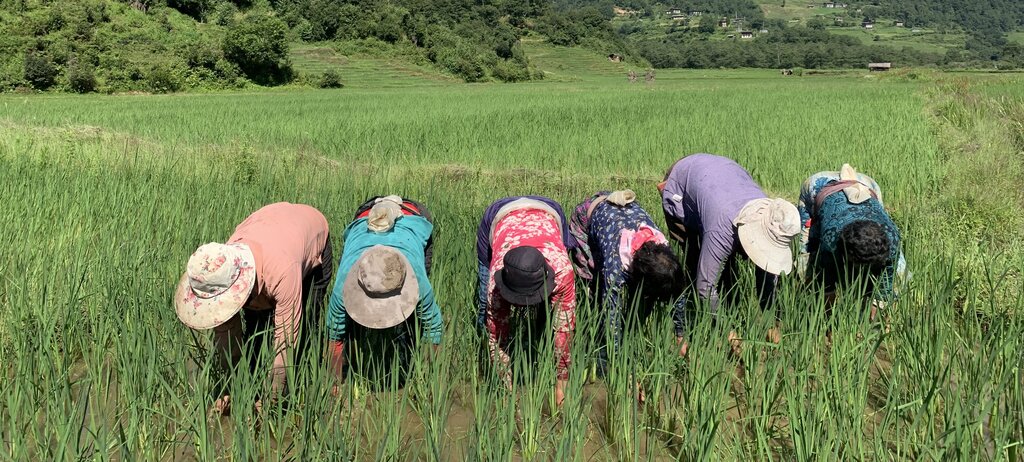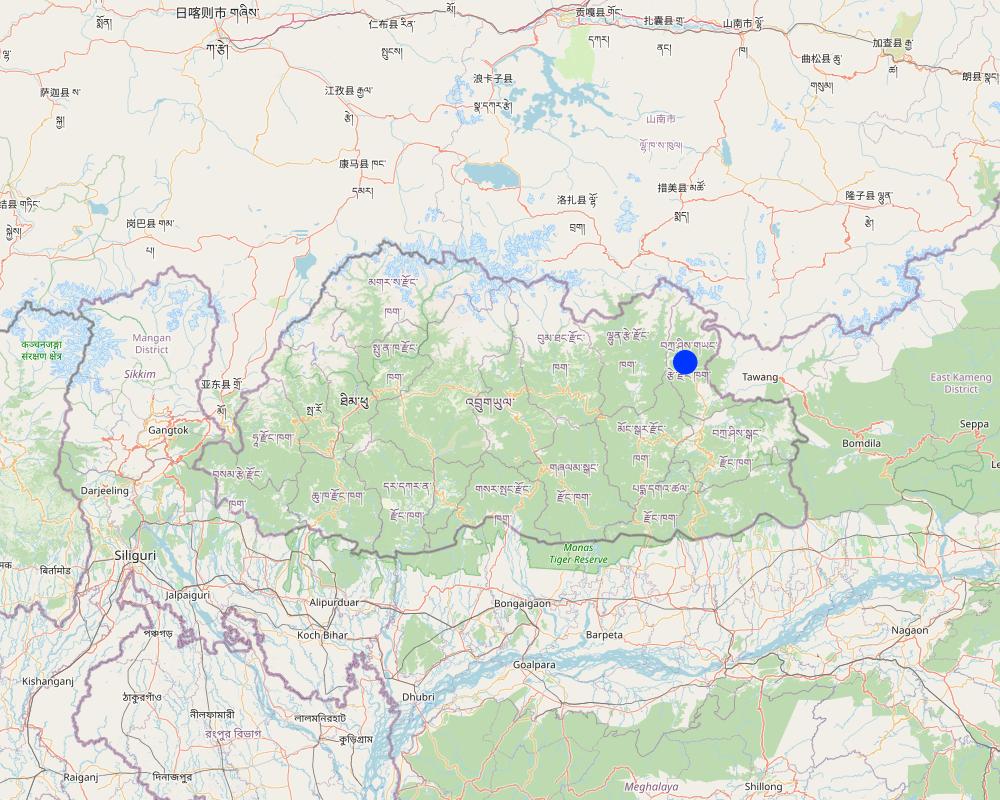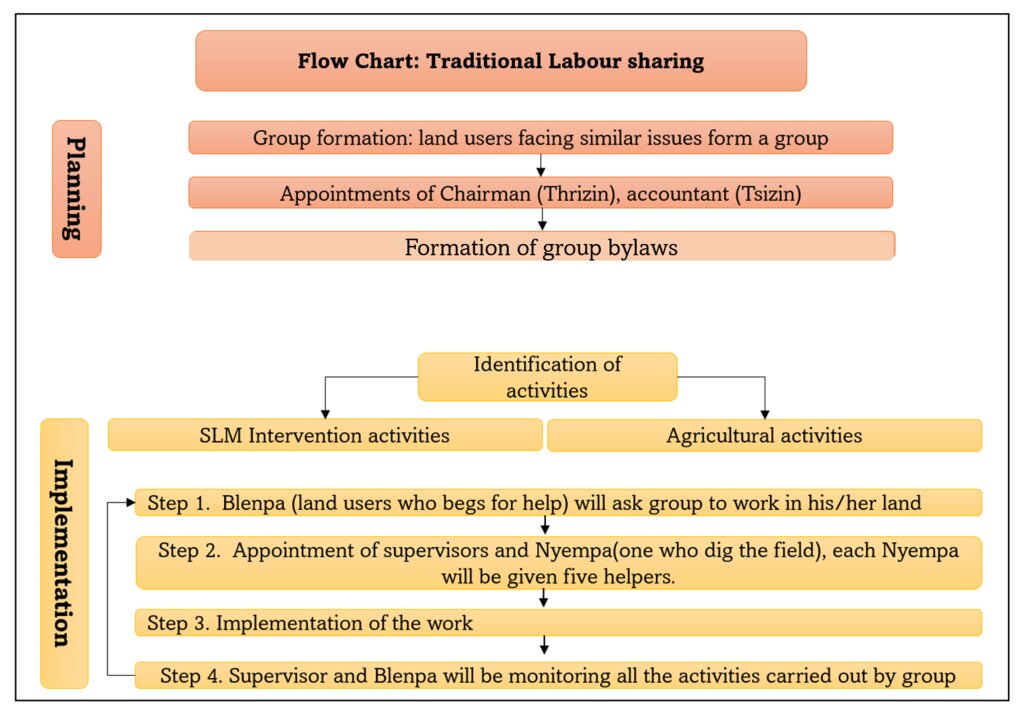Traditional labour sharing for farming [ប្រទេសប៊ូតង់]
- ការបង្កើត៖
- បច្ចុប្បន្នភាព
- អ្នកចងក្រង៖ ONGPO LEPCHA
- អ្នកកែសម្រួល៖ Tashi Wangdi
- អ្នកត្រួតពិនិត្យច្រើនទៀត៖ William Critchley, Rima Mekdaschi Studer
Latsab
approaches_6894 - ប្រទេសប៊ូតង់
ពិនិត្យមើលគ្រប់ផ្នែក
ពង្រីកមើលទាំងអស់ បង្រួមទាំងអស់1. ព័ត៌មានទូទៅ
1.2 ព័ត៌មានលម្អិតពីបុគ្គលសំខាន់ៗ និងស្ថាប័នដែលចូលរួមក្នុងការវាយតម្លៃ និងចងក្រងឯកសារនៃវិធីសាស្ត្រផ្សព្វផ្សាយ
បុគ្គលសំខាន់ម្នាក់ (ច្រើននាក់)
អ្នកប្រើប្រាស់ដី:
Geduula
17324491
Namthurang wog, Betsamaang, Bumdeling, Trashi Yangtse District
ប្រទេសប៊ូតង់
អ្នកប្រើប្រាស់ដី:
Dema Karma
17328742
Namthurang wog, Betsamaang, Bumdeling, Trashi Yangtse District
ប្រទេសប៊ូតង់
អ្នកប្រើប្រាស់ដី:
Pelden Tshering
17371568
Namthurang wog, Betsamaang, Bumdeling, Trashi Yangtse District
ប្រទេសប៊ូតង់
អ្នកប្រើប្រាស់ដី:
Tshering Gonpo
17559260
Namthurang wog, Betsamaang, Bumdeling, Trashi Yangtse District
ប្រទេសប៊ូតង់
អ្នកប្រើប្រាស់ដី:
Wangmo Ugyen
17278903
Namthurang wog, Betsamaang, Bumdeling, Trashi Yangtse District
ប្រទេសប៊ូតង់
អ្នកប្រើប្រាស់ដី:
Karma
17363810
Namthurang wog, Betsamaang, Bumdeling, Trashi Yangtse District
ប្រទេសប៊ូតង់
អ្នកប្រើប្រាស់ដី:
Gurula
17718668
Namthurang wog, Betsamaang, Bumdeling, Trashi Yangtse District
ប្រទេសប៊ូតង់
អ្នកប្រើប្រាស់ដី:
Choden Karma
17781323
Namthurang wog, Betsamaang, Bumdeling, Trashi Yangtse District
ប្រទេសប៊ូតង់
អ្នកប្រើប្រាស់ដី:
Chozom Sither
17743907
Namthurang wog, Betsamaang, Bumdeling, Trashi Yangtse District
ប្រទេសប៊ូតង់
អ្នកប្រើប្រាស់ដី:
Gonpo Tshewang
17705121
Namthurang wog, Betsamaang, Bumdeling, Trashi Yangtse District
ប្រទេសប៊ូតង់
ឈ្មោះគម្រោងដែលបានចងក្រងឯកសារ/ វាយតម្លៃលើវិធីសាស្ត្រផ្សព្វផ្សាយ (បើទាក់ទង)
Strengthening national-level institutional and professional capacities of country Parties towards enhanced UNCCD monitoring and reporting – GEF 7 EA Umbrella II (GEF 7 UNCCD Enabling Activities_Umbrella II)ឈ្មោះអង្គភាពមួយ (ច្រើន) ដែលបានចងក្រងឯកសារ/ វាយតម្លៃលើវិធីសាស្ត្រផ្សព្វផ្សាយ (បើទាក់ទង)
National Soil Services Centre, Department of Agriculture, Ministry of Agriculture & Livestock (NSSC) - ប្រទេសប៊ូតង់1.3 លក្ខខណ្ឌទាក់ទងទៅនឹងការប្រើប្រាស់ទិន្នន័យដែលបានចងក្រងតាមរយៈវ៉ូខេត
តើពេលណាដែលទិន្នន័យបានចងក្រង (នៅទីវាល)?
20/7/2023
អ្នកចងក្រង និង(បុគ្គលសំខាន់ៗ)យល់ព្រមទទួលយកនូវលក្ខខណ្ឌនានាទាក់ទងទៅនឹងការប្រើប្រាស់ទិន្នន័យដែលបានចងក្រងតាមរយៈ វ៉ូខេត:
បាទ/ចា៎
2. ការពណ៌នាអំពីវិធីសាស្ត្រផ្សព្វផ្សាយ SLM
2.1 ពណ៌នាសង្ខេបខ្លីពីវិធីសាស្ត្រផ្សព្វផ្សាយ
In the past, it was difficult for households to complete seasonal farming activities like ploughing, sowing, and transplanting in time. So, land users came together by adopting 'latsab' or labour sharing. This involves pooling land users, who work on a rotational basis on the plots of the different group members. Labour sharing is a very old approach but is still being practiced throughout the country.
2.2 ពណ៌នាលម្អិតពិវិធីសាស្ត្រផ្សព្វផ្សាយ
ពណ៌នាលម្អិតពិវិធីសាស្ត្រផ្សព្វផ្សាយ:
In the past, it was difficult for households to complete seasonal farming activities like ploughing, sowing, and transplanting in time. So, land users came together by adopting 'latsab' or labour sharing. This involves pooling land users, who work on a rotational basis on the plots of the different group members. Labour sharing is a very old approach but is still being practiced throughout the country. In addition, land users also come together for any construction work or other activities related to land management. Labour sharing aims to complete seasonal farming activities more efficiently and on time. The approach also helps economically disadvantaged land users who cannot pay wages to employ. Other co-benefits reported are the improved sense of community and enhanced social cohesion because the exchange of experiences and collaboration builds mutual trust. Working in a group eases hard physical work, such as carrying and breaking large boulders, and is perceived to be much more enjoyable than working alone or in a household setting.
Groups are formed at the village and sub-village levels to enable households to take up labour-intensive SLM activities, such as stone bunding, bench terracing, stone check dam construction, water source protection works, or grass hedgerow development. Labour-sharing involves land users coming together to discuss important agricultural activities to be implemented. They also select the land users where the work should start. When it comes to activities related to SLM intervention, the land users are given initial practical training on the SLM intervention, which starts with hands-on work on the land of a group member, preferably that of a vulnerable household. Labour-sharing groups, therefore, facilitate the inclusion of vulnerable households, especially female-headed and small families, in the implementation of labour-intensive SLM interventions. In addition to technical guidance provided by extension staff, support is given to the group formation process, such as drafting informal by-laws and group management.
Any activities through a labour-sharing approach have to undergo specific stages. Initially, the land users will come together to discuss important agricultural or SLM activities to be carried out in a season. Secondly, they identify a 'Blenpa' who is a land user who requests help on his/ her land. Once in the field before they start any activities a supervisor or 'la pon' is appointed. If work involves heavy digging, a 'Nyempa' (preferably a strong man) is appointed, and he will be assisted by four or five women. The labour-sharing group is formed through common interests among different land users in the community. The group members come together and plan and prepare by-laws. They appoint a chairman or 'Trizin', who is the overall manager of the group. The accountant/treasurer or 'Tsezin' is appointed to take care of the finances. Any conflict between land users is solved within the group.
2.3 រូបភាពនៃវិធីសាស្ត្រផ្សព្វផ្សាយ
2.5 ប្រទេស/តំបន់/ទីតាំងកន្លែង ដែលវិធីសាស្ត្រផ្សព្វផ្សាយត្រូវបានអនុវត្តន៍
ប្រទេស:
ប្រទេសប៊ូតង់
តំបន់/រដ្ឋ/ខេត្ត:
Namthrang wog (sub village), Betsamaang(village), Bumdeling(region), Trashi Yangtse(Provience)
Map
×2.6 កាលបរិច្ឆេទនៃការចាប់ផ្តើម និងបញ្ចប់នៃវិធីសាស្រ្តផ្សព្វផ្សាយនេះ
ប្រសិនអត់ចាំឆ្នាំ សូមចង្អុលបង្ហាញកាលបរិច្ឆេទប្រហែលៗពេលដែលវិធីសាស្ត្រផ្សព្វផ្សាយត្រូវបានចាប់ផ្តើមប្រើ:
ច្រើនជាង 50 ឆ្នាំមុន (ប្រពៃណី)
មតិយោបល់:
The exact date and year of initiation are not known as this approach has been practiced by their ancestors.
2.7 ប្រភេទនៃវិធីសាស្ត្រផ្សព្វផ្សាយ
- ក្រុមប្រពៃណី/ក្រុមជនជាតិភាគតិច
2.8 គោលបំណង/ទិសដៅសំខាន់នៃវិធីសាស្ត្រផ្សព្វផ្សាយ
The main aims/objectives of the approach are 1) Labour-sharing to complete seasonal activities faster and on time, 2) To support economically disabled land users who cannot pay for hired workers, and 3) To share resources like water which is important for carrying out farming activities.
2.9 លក្ខខណ្ឌអនុញ្ញាត ឬរារាំងការអនុវត្តន៍បច្ចេកទេសដែលស្ថិតនៅក្រោមវិធីសាស្រ្តផ្សព្វផ្សាយ
សង្គម/វប្បធម៌/ និងតម្លៃនៃសាសនា
- អំណោយផល
All land users involved are from same ethnic group. They shared common social, cultural, and religious, norms and values. Implementation of any SLM activities was seen as enabling.
ភាពអាចរកបាននៃធនធានហិរញ្ញវត្ថុ និងសេវាកម្ម
- អំណោយផល
Land users were accessible to financial resources and services as most of them are either members of a vegetable group or a Chilli group. As a member, they are privileged to avail loans.
ការសហការ/ការសម្របសម្រួលតួអង្គពាក់ព័ន្ធ
- អំណោយផល
The group formation is democratic and the leader selected to regulate the group was selected by land users themselves. Therefore, strong collaboration is observed.
ចំណេះដឹងស្តីពី SLM និងការទទួលបានការគាំទ្រផ្នែកបច្ចេកទេស
- អំណោយផល
Land users are aware of SLM interventions like terracing, bunding, stone bunding, growing Napier grass, etc. These indicated that they have good knowledge and are accessible to technical support from SLM specialists.
ទីផ្សារ (ទិញធាតុចូល លក់ផលិតផល) និងតម្លៃ
- អំណោយផល
Land users indicated that they have a good market for their produce like chilli and potatoes. They have a group that deals with marketing.
ទំហំការងារ ភាពអាចរកបាននៃកម្លាំងពលកម្ម
- អំណោយផល
Land users are happy that the current approach of labour-sharing helped them a lot when it comes to workload and labour shortage. Although if there are fewer household members, the approach helps them to carry out important agricultural activities in time.
3. ការចូលរួម និងតួនាទីរបស់ភាគីពាក់ព័ន្ធ
3.1 អ្នកពាក់ព័ន្ធដែលបានចូលរួមក្នុងវិធីសាស្ត្រផ្សព្វផ្សាយ និងតួនាទីរបស់ពួកគេ
- អ្នកប្រើប្រាស់ដីក្នុងតំបន់/សហគមន៍
10 households were involved out of which 6 are females and 4 are male. They are mostly from the age group between 40-60 years old, All of them are married and are economically disabled. All of them belong to the same ethnic group known as
Land users are involved in the planning of by-laws, and implementation of activities, Elected chairman is responsible for the smooth functioning of the group. The accountant takes care of the finances. Any conflict between land users is solved within the group.
- អ្នកឯកទេសគ្រប់គ្រងដីប្រកបដោយចីរភាព/ទីប្រឹក្សាបច្ចេកទេសកសិកម្ម
Extension agent
He/she is not part of the group but is involved whenever he/she needs assistance from the group. He/she acts as an SLM specialist at the village level.
3.2 ការចូលរួមរបស់អ្នកប្រើប្រាស់ដីក្នុងតំបន់/ សហគមន៍ក្នុងតំបន់ក្នុងដំណាក់កាលផ្សេងគ្នានៃវិធីសាស្រ្តផ្សព្វផ្សាយ
| ការចូលរួមរបស់អ្នកប្រើប្រាស់ដីក្នុងតំបន់/សហគមន៍ក្នុងតំបន់ | សូមបញ្ជាក់នរណាត្រូវបានចូលរួម ព្រមទាំងពណ៌នាសកម្មភាពទាំងនោះ | |
|---|---|---|
| ការចាប់ផ្តើម/ការលើកទឹកចិត្ត | គំនិតផ្តួចផ្តើមដោយខ្ឡួនឯង | The labour-sharing approach was initiated by the ancestors of current land users. Current land users found this approach as an effective way to mitigate labour shortage and resource management and they continue to preserve and practice it. |
| ការរៀបចំផែនការ | គំនិតផ្តួចផ្តើមដោយខ្ឡួនឯង | Land users are the ones who come together, prepare their by-laws and plan all the activities related to farming or SLM intervention. |
| ការអនុវត្តន៍ | គំនិតផ្តួចផ្តើមដោយខ្ឡួនឯង | The approach has an elected chairman and accountant who are responsible for the smooth running of the group and finances. Any conflicts that arise between land users are solved within the group. |
| ការត្រួតពិនិត្យ និងវាយតម្លៃ | គំនិតផ្តួចផ្តើមដោយខ្ឡួនឯង | The group is monitored by the chairman. During the time of any activities, they also appoint a supervisor who will monitor the quality of the work performed by the members. |
3.3 គំនូសបំព្រួញ (ប្រសិនបើមាន)
ការពណ៌នា:
Flow chart created following conversation with the group. There are two important phases, initially planning which includes group formation, and by-law, and the second phase is the implementation phase.
អ្នកនិពន្ធ:
Ongpo Lepcha
3.4 ការសម្រេចចិត្តលើការជ្រើសរើសបច្ចេកទេស SLM
សូមបញ្ជាក់តើអ្នកណាជាអ្នកបានសម្រេចចិត្តក្នុងការជ្រើសរើសបច្ចេកទេសដើម្បីយកមកអនុវត្តន៍:
- អ្នកប្រើប្រាស់ដី ដោយមានការគាំទ្រពីអ្នកជំនាញឯកទេស SLM
ចូរពន្យល់:
The technologies implemented by land users have been decided by land users and upon their request to the government the SLM specialist are sent and technology related training and materials are provided to the group.
4. ជំនួយបច្ចេកទេស ការកសាងសមត្ថភាព និងការគ្រប់គ្រងចំណេះដឹង
4.1 ការកសាងសមត្ថភាព/ បណ្តុះបណ្តាល
តើវគ្គបណ្តុះបណ្តាលបានផ្តល់ឱ្យអ្នកប្រើប្រាស់ដី/អ្នកពាក់ព័ន្ធផ្សេងៗទៀតដែរឬទេ?
បាទ/ចា៎
សូមបញ្ជាក់តើអ្នកណាត្រូវបានបណ្តុះបណ្តាល:
- អ្នកប្រើប្រាស់ដី
ទម្រង់នៃការបណ្តុះបណ្តាល:
- ទីតាំងបង្ហាញ
ប្រធានបទបណ្តុះបណ្តាល:
Improved ways to dry Chilli, Nursery bed preparation, electric fencing, Growing Napier grass, Chainlink fencing, Greenhouse construction, etc.,
មតិយោបល់:
The training was provided by extension agents
4.2 សេវាផ្តល់ប្រឹក្សាយោបល់
តើអ្នកប្រើប្រាស់ដីបានទទួលនូវសេវាផ្តល់ប្រឹក្សាដែរ ឬទេ?
បាទ/ចា៎
ពណ៌នា/ពន្យល់:
Whenever there is an outbreak of crops or livestock diseases, advisory services are provided by agricultural and livestock officers on do and don't of the issues.
4.3 ការពង្រឹងសមត្ថភាពស្ថាប័ន (ការអភិរឌ្ឍន៍អង្គភាព)
តើស្ថាប័នទាំងអស់ត្រូវបានបង្កើតឡើង ឬពង្រឹងសមត្ថភាពតាមរយៈវិធីសាស្ត្រផ្សព្វផ្សាយដែរ ឬទេ?
- បាទ/ច៎ា បានខ្លាំង
សូមបញ្ជាក់ថាតើស្ថាប័នត្រូវបានពង្រឹង ឬបង្កើតឡើងនៅត្រឹមកម្រិតណា(ច្រើន)?
- ថ្នាក់មូលដ្ឋាន
ចូពណ៌នាពីស្ថាប័ន តួនាទី និងទំនួលខុសត្រូវ សមាជិក ។ល។:
Within the labour-sharing group, land users also have formed other groups like the Chilli group (focusing on cultivating and marketing chilli), Vegetable group (involved in growing and marketing vegetables other than chilli)
សូមបញ្ជាក់ប្រភេទនៃការគាំទ្រ:
- ហិរញ្ញវត្ថុ
- ការកសាងសមត្ថភាព/ បណ្តុះបណ្តាល
- សម្ភារៈ
សូមផ្តល់ព័ត៌មានបន្ថែមទៀតឱ្យបានលម្អិត:
The financial institution provides loans to those land users who are members of the group. Support from the government and external projects targeted to the groups. As a result, members of the group have received training in Chilli drying through the Tarayana Foundation. Members also shared that when they work in groups they also share tools, equipments, machinary, etc., which indirectly reduces the cost.
4.4 ការត្រួតពិនិត្យ និងវាយតម្លៃ
តើការត្រួតពិនិត្យ និងវាយតម្លៃគឺជាផ្នែកមួយនៃវិធីសាស្ត្រដែរឬទេ?
បាទ/ចា៎
មតិយោបល់:
Labour sharing involves working on a rotation basis. The group has a chairman who monitors the overall activities of the group. When it comes to agricultural or SLM intervention activities carried out at individual land user's fields. The supervisor is appointed who monitors and supervises the work.
ប្រសិន បាទ/ច៎ា តើឯកសារនេះបានបង្កើតឡើងក្នុងគោលបំណងប្រើប្រាស់សម្រាប់ការត្រួតពិនិត្យ និងវាយតម្លៃដែរឬទេ?
ទេ
4.5 ការស្រាវជ្រាវ
តើការស្រាវជ្រាវ គឺជាផ្នែកមួយនៃវិធីសាស្រ្តដែរឬទេ?
ទេ
5. ថវិកា និងសម្ភារៈឧបត្ថម្ភពីខាងក្រៅ
5.1 ថវិកាប្រចាំឆ្នាំសម្រាប់ផ្សព្វផ្សាយ SLM
មតិយោបល់ (ឧ. ប្រភពសំខាន់នៃមូលនិធិ/ម្ចាស់ជំនួយចំបង):
The group is mainly formed by those land users who are economically disabled. They work on a rotation basis so that they don't have to pay for human resources involved in carrying out any agricultural or SLM intervention activities.
5.2 ការគាំទ្រផ្នែកហិរញ្ញវត្ថុ / សម្ភារៈដែលបានផ្តល់ទៅឱ្យអ្នកប្រើប្រាស់ដី
តើអ្នកប្រើប្រាស់ដីបានទទួលការគាំទ្រផ្នែកហិរញ្ញវត្ថ/សម្ភារៈសម្រាប់ការអនុវត្តន៍បច្ចេកទេសដែរឬទេ:
បាទ/ចា៎
ប្រសិនបាទ/ច៎ា សូមបញ្ជាក់ប្រភេទ(ច្រើន)នៃការគាំទ្រ លក្ខខណ្ឌ និងអ្នកផ្តល់ឱ្យ(ច្រើន):
Electric fencing: The materials were supported by the government.
Chilli dryer:
5.3 សូមបញ្ជាក់ពីធាតុចូលត្រូវបានផ្តល់បដិភាគ (រួមទាំងកម្លាំងពលកម្ម)
- សម្ភារៈ
| សូមបញ្ជាក់ ធាតុចូលណាខ្លះដែលបានផ្តល់បដិភាគ | កម្រិតទំហំប៉ុណ្ណា | សូមបញ្ជាក់ពីការបដិភាគ |
|---|---|---|
| Chilli Dryer | ផ្តល់ហិរញ្ញវត្ថុទាំងស្រុង | They received one dryer from the Women's Division under the National Commission for Women and Children (NCWC). |
- ការសាងសង
| សូមបញ្ជាក់ ធាតុចូលណាខ្លះដែលបានផ្តល់បដិភាគ | កម្រិតទំហំប៉ុណ្ណា | សូមបញ្ជាក់ពីការបដិភាគ |
|---|---|---|
| Electric fencing | ផ្តល់ហិរញ្ញវត្ថុទាំងស្រុង | All the materials required for electric fencing were provided by the Bhutan government. |
- ហេដ្ឋារចនាសម្ព័ន្ធ
- ផ្សេងៗ
| ផ្សេងៗ (បញ្ចាក់) | កម្រិតទំហំប៉ុណ្ណា | សូមបញ្ជាក់ពីការបដិភាគ |
|---|---|---|
| Green house | ផ្តល់ហិរញ្ញវត្ថុមួយផ្នែក | The total cost for greenhouse materials was shared between individual land user and the government. 30% of the total cost is borne by land users and 70% by the government. |
ប្រសិនបើកម្លាំងពលកម្មធ្វើដោយអ្នកប្រើប្រាស់ដី តើវាជាធាតុចូលដ៏សំខាន់មួយដែរ ឬទេ:
- ផ្តល់ជារង្វាន់តាមរយៈការគាំទ្រជាសម្ភារៈ
មតិយោបល់:
All materials required were supplied by the government for free. Land users were involved in construction/installation.
5.4 ឥណទាន
តើឥណទានដែលបានផ្តល់នៅក្រោមវិធីសាស្ត្រផ្សព្វផ្សាយសម្រាប់សកម្មភាព SLM នេះយ៉ាងដូចម្តេច?
ទេ
5.5 ការលើកទឹកចិត្ត ឬវិធីសាស្ត្រដ៏ទៃទៀត
តើមានការលើកទឹកចិត្តផ្សេងទៀត ឬឧបករណ៍ប្រើប្រាស់ដើម្បីលើកកម្ពស់ការអនុវត្តន៍បច្ចេកទេស SLM?
បាទ/ចា៎
បើបាទ/ចា៎ សូមបញ្ជាក់:
The group also received a cake-making machine. However, this was shared among different groups from other places.
6. ការវិភាគរកផលប៉ះពាល់ និងសេចក្តីសន្និដ្ឋាន
6.1 ផលប៉ះពាល់នៃវិធីសាស្ត្រផ្សព្វផ្សាយ
តើវិធីសាស្ត្រផ្សព្វផ្សាយបានផ្តល់សិទ្ធិអំណាចដល់អ្នកប្រើប្រាស់ដី ធ្វើឱ្យប្រសើរឡើងនូវការចួលរួមអ្នកពាក់ព័ន្ធ?
- ទេ
- បាទ/ច៎ា បន្តិចបន្តួច
- បាទ/ច៎ា ជាមធ្យម
- បាទ/ច៎ា បានខ្លាំង
Yes, the approach has empowered local land users. Gender equality is maintained and Chairmanship is done on a rotation basis. The work done by the group is supported by government and other external projects.
តើវិធីសាស្ត្រផ្សព្វផ្សាយជួយអ្នកប្រើប្រាស់ដីដើម្បីអនុវត្តន៍ និងថែទាំបច្ចេកទេស SLM?
- ទេ
- បាទ/ច៎ា បន្តិចបន្តួច
- បាទ/ច៎ា ជាមធ្យម
- បាទ/ច៎ា បានខ្លាំង
The group is basically focused on agricultural activities and to protect their crop from wildlife they have installed electric fencing. They also rear dairy as a source of manure to improve the fertility of the soil.
តើវិធីសាស្ត្រផ្សព្វផ្សាយនេះធ្វើឱ្យចំណេះដឹងប្រសើឡើង និងសមត្ថភាពរបស់អ្នកប្រើប្រាស់ដីក្នុងការអនុវត្តន៏ SLM?
- ទេ
- បាទ/ច៎ា បន្តិចបន្តួច
- បាទ/ច៎ា ជាមធ្យម
- បាទ/ច៎ា បានខ្លាំង
Government and external support is directed to the group because it is quite cheaper than providing to individual land users. Any kind of capacity development related to agricultural activities or SLM intervention is given to the group. Group members also shared that they received training in various fields of SLM like stone bunding, Terracing, Electric fencing, greenhouse construction, and improved dairy shed construction.
តើវីធីសាស្ត្រផ្សព្វផ្សាយនេះបានកាត់បន្ថយជំលោះឬទេ?
- ទេ
- បាទ/ច៎ា បន្តិចបន្តួច
- បាទ/ច៎ា ជាមធ្យម
- បាទ/ច៎ា បានខ្លាំង
Establishment of the electric fencing solved human-wildlife conflicts. Irrigation water used to be an important issue for conflict in the past. However, group formation has helped the community improve their irrigation by improving source and also scheduling irrigation timing among the members.
តើវិធីសាស្ត្រផ្សព្វផ្សាយនេះផ្តល់សិទ្ធិអំណាចដល់សង្គមនិងសេដ្ឋកិច្ចដែលក្រុមមិនទទួលបានផលប្រយោជន៍?
- ទេ
- បាទ/ច៎ា បន្តិចបន្តួច
- បាទ/ច៎ា ជាមធ្យម
- បាទ/ច៎ា បានខ្លាំង
The group consists of members who are economically disabled. The group has helped them to sustain their livelihood as any agricultural activities are carried out in time. The members also don't have to pay for labours which otherwise is very expensive. Working together also builds a sense of belongingness and closeness among the members.
តើវិធីសាស្ត្រផ្សព្វផ្សាយធ្វើឱ្យប្រើសើរឡើងនូវការស្វែងរកទីផ្សារ?
- ទេ
- បាទ/ច៎ា បន្តិចបន្តួច
- បាទ/ច៎ា ជាមធ្យម
- បាទ/ច៎ា បានខ្លាំង
The members of the Labour-sharing group are also members of other groups like the Chilli and Vegetable group. This has helped them to market their produce.
6.2 ការលើកទឹកចិត្តចម្បងៗរបស់អ្នកប្រើប្រាស់ដីសម្រាប់ការអនុវត្តបច្ចេកទេស SLM
- បង្កើនផលិតកម្ម
Every agricultural activity carried out by the group is monitored thus improving the conditions in which a crop grows, thus increasing production.
- បង្កើនប្រាក់ចំណេញ (សមត្ថភាព) បង្កើនអត្រាចំណេញ
Members of the group work on a rotation basis thus reducing production costs and increasing the cost-benefit ratio.
- ការកាត់បន្ថយការធ្លាក់ចុះគុណភាពដី
Agricultural activities are done manually thus reducing land degradation.
- កាត់បន្ថយហានិភ័យនៃគ្រោះមហន្តរាយ
Agricultural activities are seasonal and every activity has to be done in time. Labor-sharing groups helped members to complete these activities in time thus reducing the risk of disaster.
- កាត់បន្ថយទំហំការងារ
Group members come together and work for a common goal thus reducing workload.
- ការកាត់បន្ថយជម្លោះ
Member shared that conflict that arises due to irrigation water is no more.
6.3 សកម្មភាពផ្សព្វផ្សាយដែលប្រកបដោយចីរភាព
តើអ្នកប្រើប្រាស់ដីអាចធ្វើឱ្យមានចីរភាពនូវអ្វីដែលត្រូវបានអនុវត្តន៍តាមរយៈវិធីសាស្ត្រផ្សព្វផ្សាយដែរឬទេ(ដោយពុំមានការគាំទ្រពីអ្នកខាងក្រៅ)?
- មិនប្រាកដ
ប្រសិន ទេ ឬមិនប្រាកដសូមបញ្ជាក់ និងពន្យល់:
The approach was there in the past when external support was not there. It is continuing today, but it is uncertain whether this approach will survive in the future with changing climate and improving the lifestyle of every farmer.
6.4 ភាពខ្លាំង/ គុណសម្បត្តិនៃវិធីសាស្ត្រផ្សព្វផ្សាយ
| ភាពខ្លាំង/ គុណសម្បត្តិ/ ឱកាស ទស្សនៈរបស់អ្នកប្រើប្រាស់ដី |
|---|
| The approach allows members to enhance social cohesion and community sense. They come together for any kind of work, thus tackling the main issue of labour shortage and easing hard physical work. |
| Agricultural activities like ploughing, tilling, sowing, transplanting, weeding, watering, and harvesting, have to be completed on time. The approach allows every member to complete these activities on time avoiding crop failure and enhancing crop production. |
| The approach includes all vulnerable groups giving them opportunities to share their problems and supporting them through labour-sharing to carry out important agricultural activities for crop production. |
| ភាពខ្លាំង/ គុណសម្បត្តិ/ ឱកាស ទស្សនៈរបស់បុគ្គលសំខាន់ៗ |
|---|
| The approach demands equal participation from all household members. Thus giving training on any SLM intervention activities by SLM experts becomes very easy. It is also easy to communicate to the group for dissemination of any information. |
| The approach helps the economically disabled members to sustain their livelihood. This is because labour-sharing cut many of the costs involved in crop production or SLM intervention activities increasing the cost-benefit ratio. |
6.5 ភាពខ្សោយ/ គុណវិបត្តិនៃវិធីសាស្ត្រ និងរកដំណោះស្រាយ
| ភាពខ្សោយ/ គុណវិបត្តិ/ ហានិភ័យ ទស្សនៈរបស់អ្នកប្រើប្រាស់ដី | តើបច្ចេកទេសទាំងនោះបានដោះស្រាយបញ្ហាដូចម្តេច? |
|---|---|
| Marketing of agricultural produce: There are many other groups at the village and sub-district level. They compete to capture the local market which is always saturated with supply. Exploring the market at the domestic and international levels is very expensive for the majority of the group. | The government takes some initiative to explore the market for these groups or give them some incentives to do marketing like marketing van. |
| ភាពខ្សោយ/ គុណវិបត្តិ/ ហានិភ័យក្នុងទស្សនៈរបស់បុគ្គលសំខាន់ៗ | តើបច្ចេកទេសទាំងនោះបានដោះស្រាយបញ្ហាដូចម្តេច? |
|---|---|
| The sustainability of the group: Most of the members are between the age group of 40-70. The young generation is not interested in agriculture and in the future, there are chances that this kind of group may die. | The government must take some initiative to make our young generation like Agriculture by bringing new technologies that will ease hard human labour. |
7. ឯកសារយោង និងវេបសាយ
7.1 វិធីសាស្ត្រ/ ប្រភពនៃព័ត៌មាន
- តាមការចុះទីវាល ការស្រាវជ្រាវនៅទីវាល
Three sites were visited to see the group working.
- ការសម្ភាសន៍ជាមួយអ្នកប្រើប្រាស់ដី
10 land users representing 10 households were interviewed.
- ការចងក្រងពីរបាកការណ៍ និងឯកសារផ្សេងៗទៀតដែលមាន
5
7.2 ឯកសារយោងដែលបានចេញផ្សាយ
ចំណងជើង អ្នកនិពន្ធ ឆ្នាំ ISBN:
BHUCAT (Bhutan catalogue of soil and water conservation approaches and technologies):Best practices and guidelines from Bhutan for sustainable land managements on steep to very steep slopes, National Soil Service Center, Department of Agriculture, Ministry of Agriculture and Forest 2012,
មានប្រភពមកពីណា? ថ្លៃដើមប៉ុន្មាន?
A copy of a book was provided by National Soil Service Center, Simtokha: Bhutan for Free.
ចំណងជើង អ្នកនិពន្ធ ឆ្នាំ ISBN:
2021 Labour force survey report Bhutan, National statistics Bureau, 2021, ISBN 978-99936-28-93-4
មានប្រភពមកពីណា? ថ្លៃដើមប៉ុន្មាន?
available online for free. https://www.nsb.gov.bt/wp-content/uploads/dlm_uploads/2022/04/LFS-2021-web.pdf
7.3 ចូលទៅទាញយកឯកសារពាក់ព័ន្ធដែលមានលើបណ្តាញអ៊ិនធឺណែត
ចំណងជើង/ ពណ៌នា:
SLM Labour-sharing group Bhutan
វេបសាយ:
https://qcat.wocat.net/wocat/approaches/view/approaches_2491/
ចំណងជើង/ ពណ៌នា:
Sharing labour to implement contour bunding in Nepal
វេបសាយ:
https://qcat.wocat.net/wocat/approaches/view/approaches_2604/
ចំណងជើង/ ពណ៌នា:
Organic agriculture, Labour exchange, and social networks: a case study of smallholder farming in Bhutan
វេបសាយ:
https://link.springer.com/article/10.1007/s13165-022-00416-z
ការតភ្ជាប់ និងម៉ូឌុល
ពង្រីកមើលទាំងអស់ បង្រួមទាំងអស់ការតភ្ជាប់
គ្មានការតភ្ជាប់
ម៉ូឌុល
គ្មានម៉ូឌុល


